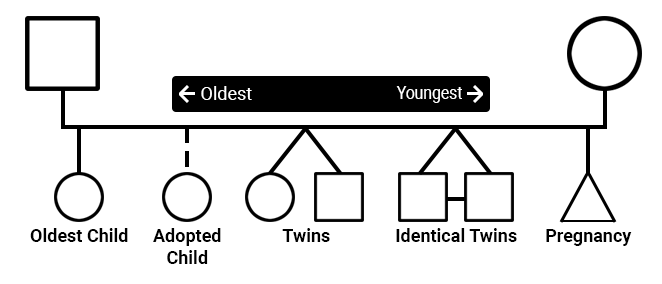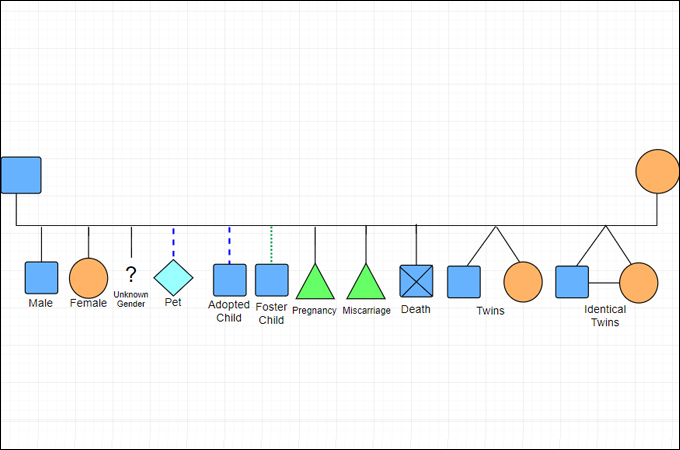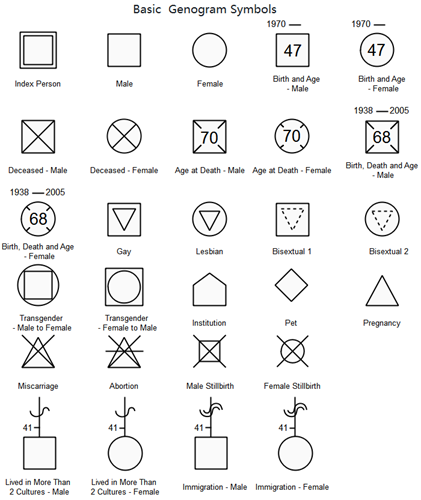

GENOGRAM EXAMPLE WITH KEY HOW TO
Rather, we hope to eventually understand the principles of how to design and create useful catalytic systems based on enzyme mechanisms.How do you show a dead person on a genogram? ‘This means that this supermolecule is controlling its own chemistry,’ Sanders says.Īlthough the researchers have taken their lead from nature, Sanders emphasises: ‘Our aim is not to mimic any particular enzyme.

In fact, the bound amine reacts with the steroid cap. Binding of a substrate is the first step in enzymic catalysis so this bodes well for future catalysts. The capped porphyrin has a reactive site that can ‘recognise’ and bind to an amine. Such molecules could be used to transport hydrophilic drugs across cell walls, acting as selective agents to deliver drugs.īy combining porphyrins with the cyclocholates, the researchers have made a steroid-capped porphyrin which they believe also has promise as a catalyst (Journal of the Chemical Society, Chemical Communications, 1991, p 574). The outside of the molecule is hydrophobic or oily.

They have made cyclic polymers ‘cyclocholates’ with large water-attracting, or hydrophilic, cavities. Sanders and his colleagues are also building supermolecules using the steroid cholic acid. ‘The idea is to get two molecules in close proximity inside the cavity in the hope of making them react catalytically,’ he says.

Sanders’ group is investigating the potential of these molecules. The size of the cavity determines which substrate molecules will fit inside the ring, and so is important in finding catalytic applications. The effect is more efficient when a slightly different porphyrin derivative is used and tripyridyltriazine is used as the template, although in this case the cavity is smaller (0.16 nanometres). ‘The relevant aspect of this process, however, is that we can make a macrocycle with a cavity defined by our template molecule,’ Sanders says. The resulting ring has a cavity about 0.18 nanometres in diameter. The chemists released the trimer from the template molecule by removing the zinc atoms from the centre of each porphyrin ring. According to Sanders, very few molecules have quite as many different elements. The resulting supermolecule – a cyclic trimer with an aluminium template held in the centre – has the amazing formula C 210H 246P 6O 6Pt 3Zn 3Al (see Diagram). The researchers believe that during this step the porphyrin dimer wraps itself around the triangular aluminium-containing template, bringing the the reactive ends close so that a third porphyrin can couple to complete the ring (Journal of the Chemical Society, Chemical Communications, 1992, p 43). They then used the template effect to carry out a further controlled coupling, this time using tris(pyridinylacetoacetate) aluminium as the template. Sanders and his colleagues made their supermolecules by incorporating zinc atoms into the centres of porphyrin molecules, then joining pairs of these to form ‘dimers’. Lithium provides a template for the formation of 12-crown-4 (C 8H 16O 4), for example. When the components of a cyclic ether are mixed with an appropriate alkali metal ion (for example, lithium), they wrap themselves spontaneously around the template ion to form a ring of a specific size. A good example of the template effect is the formation of crown ethers.


 0 kommentar(er)
0 kommentar(er)
